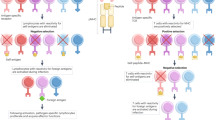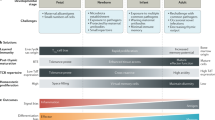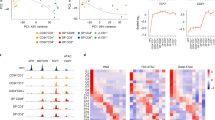Abstract
A fundamental issue in T cell development is what controls whether a thymocyte differentiates into a γδ T cell or an αβ T cell, each defined by their distinct T cell receptor. Most likely, lessons learned in studying that issue will also provide insight into how the thymus produces T cell subsets with distinct functional and regulatory potentials. Here we review recent experiments, focusing on three factors that regulate thymocyte differentiation up to and including the expression of the first products of antigen receptor gene rearrangements. Those factors are the archetypal developmental regulator Notch, intrinsic signals emanating from antigen-receptor complexes, and trans conditioning, which reflects communication between different subsets of thymocytes. We also review new findings on the positive selection of γδ T cells and on extrathymic T cell development.
This is a preview of subscription content, access via your institution
Access options
Subscribe to this journal
Receive 12 print issues and online access
$209.00 per year
only $17.42 per issue
Buy this article
- Purchase on SpringerLink
- Instant access to full article PDF
Prices may be subject to local taxes which are calculated during checkout



Similar content being viewed by others
References
Puellmann, K. et al. A variable immunoreceptor in a subpopulation of human neutrophils. Proc. Natl. Acad. Sci. USA 103, 14441–14446 (2006).
Hayday, A. Orchestrated leak provokes a thymus reassessment. Nat. Immunol. 7, 9–11 (2006).
Wu, L. et al. CD4 expressed on earliest T-lineage precursor cells in the adult murine thymus. Nature 349, 71–74 (1991).
Porritt, H.E. et al. Heterogeneity among DN1 prothymocytes reveals multiple progenitors with different capacities to generate T cell and non-T cell lineages. Immunity 20, 735–745 (2004).
Laurent, J., Bosco, N., Marche, P.N. & Ceredig, R. New insights into the proliferation and differentiation of early mouse thymocytes. Int. Immunol. 16, 1069–1080 (2004).
Hoffman, E.S. et al. Productive T-cell receptor β-chain gene rearrangement: coincident regulation of cell cycle and clonality during development in vivo. Genes Dev. 10, 948–962 (1996).
Taghon, T., Yui, M.A., Pant, R., Diamond, R.A. & Rothenberg, E.V. Developmental and molecular characterization of emerging β- and γδ-selected pre-T cells in the adult mouse thymus. Immunity 24, 53–64 (2006).
Balciunaite, G., Ceredig, R. & Rolink, A.G. The earliest subpopulation of mouse thymocytes contains potent T, significant macrophage, and natural killer cell but no B-lymphocyte potential. Blood 105, 1930–1936 (2005).
Krueger, A., Garbe, A.I. & von Boehmer, H. Phenotypic plasticity of T cell progenitors upon exposure to Notch ligands. J. Exp. Med. 203, 1977–1984 (2006).
Dudley, E.C., Petrie, H.T., Shah, L.M., Owen, M.J. & Hayday, A.C. T cell receptor β chain gene rearrangement and selection during thymocyte development in adult mice. Immunity 1, 83–93 (1994).
Capone, M., Hockett, R.D., Jr & Zlotnik, A. Kinetics of T cell receptor β, gamma, and delta rearrangements during adult thymic development: T cell receptor rearrangements are present in CD44+CD25+ pro-T thymocytes. Proc. Natl. Acad. Sci. USA 95, 12522–12527 (1998).
Livak, F., Tourigny, M., Schatz, D.G. & Petrie, H.T. Characterization of TCR gene rearrangements during adult murine T cell development. J. Immunol. 162, 2575–2580 (1999).
Mallick, C.A., Dudley, E.C., Viney, J.L., Owen, M.J. & Hayday, A.C. Rearrangement and diversity of T cell receptor β chain genes in thymocytes: a critical role for the β chain in development. Cell 73, 513–519 (1993).
Dudley, E.C., Girardi, M., Owen, M.J. & Hayday, A.C. αβ and γδ T cells can share a late common precursor. Curr. Biol. 5, 659–669 (1995).
Eberl, G. & Littman, D.R. Thymic origin of intestinal αβ T cells revealed by fate mapping of RORγt+ cells. Science 305, 248–251 (2004).
Passoni, L. et al. Intrathymic δ selection events in γδ cell development. Immunity 7, 83–95 (1997).
Lewis, J.M. et al. Selection of the cutaneous intraepithelial γδ+ T cell repertoire by a thymic stromal determinant. Nat. Immunol. 7, 843–850 (2006).
Xiong, N., Kang, C. & Raulet, D.H. Positive selection of dendritic epidermal γδ T cell precursors in the fetal thymus determines expression of skin-homing receptors. Immunity 21, 121–131 (2004).
Hayday, A.C. γδ cells—a right time and a right place for a conserved Third Way of protection. Annu. Rev. Immunol. 18, 975–1026 (2000).
Westermann, J., Ehlers, E.M., Exton, M.S., Kaiser, M. & Bode, U. Migration of naive, effector and memory T cells: implications for the regulation of immune responses. Immunol. Rev. 184, 20–37 (2001).
Cose, S., Brammer, C., Khanna, K.M., Masopust, D. & Lefrancois, L. Evidence that a significant number of naive T cells enter non-lymphoid organs as part of a normal migratory pathway. Eur. J. Immunol. 36, 1423–1433 (2006).
Lambolez, F. et al. The thymus exports long-lived fully committed T cell precursors that can colonize primary lymphoid organs. Nat. Immunol. 7, 76–82 (2006).
Gangadharan, D. et al. Identification of pre- and post-selection TCRαβ+ intraepithelial lymphocyte precursors in the thymus. Immunity 25, 631–641 (2006).
Shires, J., Theodoridis, E. & Hayday, A.C. Biological insights into TCRγδ+ and TCRαβ+ intraepithelial lymphocytes provided by serial analysis of gene expression (SAGE). Immunity 15, 419–434 (2001).
Pennington, D.J. et al. The inter-relatedness and interdependence of mouse T cell receptor γδ+ and αβ+ cells. Nat. Immunol. 4, 991–998 (2003).
Artavanis-Tsakonas, S., Rand, M. & Lake, R.J. Notch signaling: cell fate control and signal integration in development. Science 284, 770–776 (1999).
Harman, B.C. et al. T/B lineage choice occurs prior to intrathymic Notch signaling. Blood 106, 886–892 (2005).
Radtke, F. et al. Deficient T cell fate specification in mice with an induced inactivation of Notch1. Immunity 10, 547–558 (1999).
Pui, J.C. et al. Notch1 expression in early lymphopoiesis influences B versus T lineage determination. Immunity 11, 299–308 (1999).
Schmitt, T.M. & Zuniga-Pflucker, J.C. Induction of T cell development from hematopoietic progenitor cells by delta-like-1 in vitro. Immunity 17, 749–756 (2002).
Schmitt, T.M., Ciofani, M., Petrie, H.T. & Zuniga-Pflucker, J.C. Maintenance of T cell specification and differentiation requires recurrent notch receptor-ligand interactions. J. Exp. Med. 200, 469–479 (2004).
Balciunaite, G., Ceredig, R., Fehling, H.J., Zuniga-Pflucker, J.C. & Rolink, A.G. The role of Notch and IL-7 signaling in early thymocyte proliferation and differentiation. Eur. J. Immunol. 35, 1292–1300 (2005).
Mohtashami, M. & Zuniga-Pflucker, J.C. Three-dimensional architecture of the thymus is required to maintain δ-like expression necessary for inducing T cell development. J. Immunol. 176, 730–734 (2006).
Sambandam, A. et al. Notch signaling controls the generation and differentiation of early T lineage progenitors. Nat. Immunol. 6, 663–670 (2005).
Tan, J.B., Visan, I., Yuan, J.S. & Guidos, C.J. Requirement for Notch1 signals at sequential early stages of intrathymic T cell development. Nat. Immunol. 6, 671–679 (2005).
Prinz, I. et al. Visualization of the earliest steps of γδ T cell development in the adult thymus. Nat. Immunol. 7, 995–1003 (2006).
Goetz, C.A. et al. Restricted STAT5 activation dictates appropriate thymic B versus T cell lineage commitment. J. Immunol. 174, 7753–7763 (2005).
Schlissel, M.S., Durum, S.D. & Muegge, K. The interleukin 7 receptor is required for T cell receptor γ locus accessibility to the V(D)J recombinase. J. Exp. Med. 191, 1045–1050 (2000).
Boucontet, L., Sepulveda, N., Carneiro, J. & Pereira, P. Mechanisms controlling termination of V-J recombination at the TCR γ locus: implications for allelic and isotypic exclusion of TCR γ chains. J. Immunol. 174, 3912–3919 (2005).
Wolfer, A., Wilson, A., Nemir, M., MacDonald, H.R. & Radtke, F. Inactivation of Notch1 impairs VDJ-β rearrangement and allows pre-TCR-independent survival of early αβ lineage thymocytes. Immunity 16, 869–879 (2002).
Ciofani, M., Knowles, G.C., Wiest, D.L., von Boehmer, H. & Zuniga-Pflucker, J.C. Stage-specific and differential notch dependency at the αβ and γδ T lineage bifurcation. Immunity 25, 105–116 (2006).
de Smedt, M. et al. Active form of Notch imposes T cell fate in human progenitor cells. J. Immunol. 169, 3021–3029 (2002).
Garcia-Peydro, M., de Yebene, G. & Toribio, M. Sustained Notch1 signaling instructs the earliest human intrathymic precursors to adopt a γδ T-cell fate in fetal thymus organ culture. Blood 102, 2444–2451 (2003).
Jiang, R. et al. Defects in limb, craniofacial, and thymic development in Jagged2 mutant mice. Genes Dev. 12, 1046–1057 (1998).
Ciofani, M. & Zuniga-Pflucker, J.C. Notch promotes survival of pre-T cells at the β-selection checkpoint by regulating cellular metabolism. Nat. Immunol. 6, 881–888 (2005).
Edinger, A.L. & Thompson, C.B. Akt maintains cell size and survival by increasing mTOR-dependent nutrient uptake. Mol. Biol. Cell 13, 2276–2288 (2002).
Buer, J., Aifantis, I., DiSanto, J.P., Fehling, H.J. & von Boehmer, H. Role of different T cell receptors in the development of pre-T cells. J. Exp. Med. 185, 1541–1547 (1997).
Garbe, A.I., Krueger, A., Gounari, F., Zuniga-Pflucker, J.C. & von Boehmer, H. Differential synergy of Notch and T cell receptor signaling determines αβ versus γδ lineage fate. J. Exp. Med. 203, 1579–1590 (2006).
Bruno, L., Fehling, H.J. & von Boehmer, H. The αβ T cell receptor can replace the γδ receptor in the development of γδ lineage cells. Immunity 5, 343–352 (1996).
Fritsch, M., Andersson, A., Petersson, K. & Ivars, F. A TCRα transgene induces maturation of CD4−CD8− αβ+ T cells from γδ T cell precursors. Eur. J. Immunol. 28, 828–837 (1998).
Talora, C. et al. Pre-TCR-triggered ERK signalling-dependent downregulation of E2A activity in Notch3-induced T-cell lymphoma. EMBO Rep. 4, 1067–1072 (2003).
Hayes, S.M., Li, L. & Love, P.E. TCR signal strength influences αβ/γδ lineage fate. Immunity 22, 583–593 (2005).
Haks, M.C. et al. Attenuation of γδ TCR signaling efficiently diverts thymocytes to the αβ lineage. Immunity 22, 595–606 (2005).
Lauritsen, J.P., Haks, M.C., Lefebvre, J.M., Kappes, D.J. & Wiest, D.L. Recent insights into the signals that control αβ/γδ-lineage fate. Immunol. Rev. 209, 176–190 (2006).
Borowski, C., Li, X., Aifantis, I., Gounari, F. & von Boehmer, H. Pre-TCRα and TCRα are not interchangeable partners of TCRβ during T lymphocyte development. J. Exp. Med. 199, 607–615 (2004).
Hayes, S.M., Shores, E.W. & Love, P.E. An architectural perspective on signaling by the pre-αβ and γδ T cell receptors. Immunol. Rev. 191, 28–37 (2003).
Saint-Ruf, C. et al. Different initiation of pre-TCR and γδTCR signalling. Nature 406, 524–527 (2000).
Nunez-Cruz, S. et al. LAT regulates γδ T cell homeostasis and differentiation. Nat. Immunol. 4, 999–1008 (2003).
Petersson, K. & Ivars, F. Early TCR αβ expression promotes maturation of T cells expressing FcεRIγ containing TCR/CD3 complexes. J. Immunol. 166, 6616–6624 (2001).
Fujikawa, K. et al. Vav1/2/3-null mice define an essential role for Vav family proteins in lymphocyte development and activation but a differential requirement in MAPK signaling in T and B cells. J. Exp. Med. 198, 1595–1608 (2003).
Mulroy, T. & Sen, J. p38 MAP kinase activity modulates αβ T cell development. Eur. J. Immunol. 31, 3056–3063 (2001).
Terrence, K., Pavlovich, C.P., Matechak, E.O. & Fowlkes, B.J. Premature expression of T cell receptor (TCR) αβ suppresses TCR γδ gene rearrangement but permits development of γδ lineage T cells. J. Exp. Med. 192, 537–548 (2000).
Hayes, S.M. & Love, P.E. Strength of signal: a fundamental mechanism for cell fate specification. Immunol. Rev. 209, 170–175 (2006).
Aifantis, I. et al. A critical role for the cytoplasmic tail of pTα in T lymphocyte development. Nat. Immunol. 3, 483–488 (2002).
Denzel, A. et al. A chemical genetic system for the analysis of kinases regulating T cell development. J. Immunol. 171, 519–523 (2003).
Pereira, P. & Boucontet, L. Rates of recombination and chain pair biases greatly influence the primary γδ TCR repertoire in the thymus of adult mice. J. Immunol. 173, 3261–3270 (2004).
Kang, J., Volkmann, A. & Raulet, D.H. Evidence that γδ versus αβ T cell fate determination is initiated independently of T cell receptor signaling. J. Exp. Med. 193, 689–698 (2001).
Gerber, D., Boucontet, L. & Pereira, P. Early expression of a functional TCR β chain inhibits TCR γ gene rearrangements without altering the frequency of TCR γδ lineage cells. J. Immunol. 173, 2516–2523 (2004).
Krotkova, A., Smith, E., Nerz, G., Falk, I. & Eichmann, K. Delayed and restricted expression limits putative instructional opportunities of Vγ1.1/Vγ2 γδ TCR in αβ/γδ lineage choice in the thymus. J. Immunol. 173, 25–32 (2004).
Yui, M.A., Sharp, L.L., Havran, W.L. & Rothenberg, E.V. Preferential activation of an IL-2 regulatory sequence transgene in TCR γδ and NKT cells: subset-specific differences in IL-2 regulation. J. Immunol. 172, 4691–4699 (2004).
Wei, D.G. et al. Expansion and long-range differentiation of the NKT cell lineage in mice expressing CD1d exclusively on cortical thymocytes. J. Exp. Med. 202, 239–248 (2005).
Adams, E.J., Chien, Y.H. & Garcia, K.C. Structure of a γδ T cell receptor in complex with the nonclassical MHC T22. Science 308, 227–231 (2005).
Silva-Santos, B., Pennington, D. & Hayday, A.C. Lymphotoxin-mediated regulation of γδ cell differentiation by αβ T cell progenitors. Science 307, 925–928 (2005).
Lind, E.F., Prockop, S.E., Porritt, H.E. & Petrie, H.T. Mapping precursor movement through the postnatal thymus reveals specific microenvironments supporting defined stages of early lymphoid development. J. Exp. Med. 194, 127–134 (2001).
Mehr, R., Perelson, A.S., Fridkis-Hareli, M. & Globerson, A. Feedback regulation of T cell development in the thymus. J. Theor. Biol. 181, 157–167 (1996).
Pennington, D. et al. Early events in the thymus affect the balance of effector and regulatory T cells. Nature 44, 1073–1077 (2006).
Bonneville, M. et al. Transgenic mice demonstrate that epithelial homing of γ/δ T cells is determined by cell lineages independent of T cell receptor specificity. J. Exp. Med. 171, 1015–1026 (1990).
Girardi, M., Lewis, J.M., Filler, R.B., Hayday, A.C. & Tigelaar, R.E. Environmentally responsive and reversible regulation of epidermal barrier function by γδ T cells. J. Invest. Dermatol. 126, 808–814 (2006).
Visan, I. et al. Regulation of T lymphopoiesis by Notch1 and Lunatic fringe–mediated competition for intrathymic niches. Nat. Immunol. 7, 634–643 (2006).
Terszowski, G. et al. Evidence for a functional second thymus in mice. Science 312, 284–287 (2006).
Acknowledgements
We thank many colleagues for their ideas and thoughts, in particular T. Silberzahn, B. Silva-Santos and R. Tigelaar. Supported by the Wellcome Trust.
Author information
Authors and Affiliations
Corresponding authors
Ethics declarations
Competing interests
The authors declare no competing financial interests.
Rights and permissions
About this article
Cite this article
Hayday, A., Pennington, D. Key factors in the organized chaos of early T cell development. Nat Immunol 8, 137–144 (2007). https://doi.org/10.1038/ni1436
Received:
Accepted:
Published:
Issue Date:
DOI: https://doi.org/10.1038/ni1436



